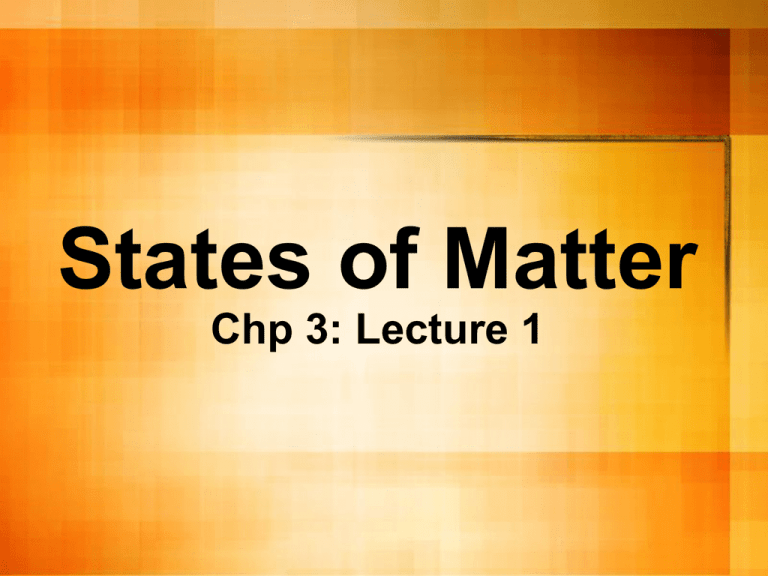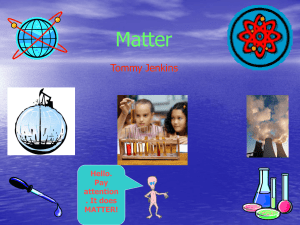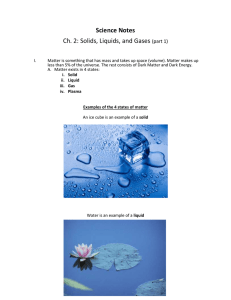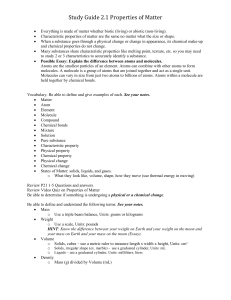Chapter 3: States of Matter
advertisement

States of Matter Chp 3: Lecture 1 QuickTime™ and a decompressor are needed to see this picture. Let’s start with Tim & Mobey States of matter 5 States All matter exists in some sort of physical form or a state of matter. There are 5 states of matter: 1. 2. 3. 4. 5. Solid Liquid Gas Plasma Bose-Einstein Condensate (BEC) The particles are movin’ Matter is made up of little atoms These atoms are constantly moving and bumping into one another. The state of matter of a substance depends on 2 things: how fast the particles are moving 2. how strongly the particles are attracted to one another 1. You Predict How do the atoms move in the following states of matter? – – – Solid Liquid Gas Guess and write your answer in the first row. Bill Nye: Phases of Matter QuickTime™ and a decompressor are needed to see this picture. The atoms move very differently Solids are solid. The atoms are locked in place and vibrate microscopically. Liquids move a little bit more. These atoms can slide past one another, but are still connected. Gases are unconnected and shoot all over the place. Matter Animation QuickTime™ and a decompressor are needed to see this picture. Solids are Soldiers The atoms in a solid are tightly packed together. That’s why they feel hard the closer your molecules are, the harder you are. Solids also can hold their own shape. A rock will always look like a rock unless something happens to it. Solids like their shape and don’t want to change. Summary: Solids have a definite volume and hold shape. Two types of Solids There are 2 types of solids: 1. Crystalline solids 2. Amorphous solids Crystalline Solids A crystalline solid has a very orderly and 3D arrangement of molecules. Think seats in a movie theater – they are all lined up, in rows and columns. That’s why solids are like soldiers - they’re all lined up in rows. Examples of Crystalline Solids Iron Diamonds Ice Salt A crystal is a solid that was slowly formed from one type of atom. We call this a pure substance. Amorphous Solids Amorphous solids are made of atoms that are in no particular order. Think of going to the beach you sit wherever there’s room. Same thing when you go see a concert in a park. Each person has a spot, but there is no order or no pattern. Examples of Amorphous Solids Amorphous solids do not have a definite melting point and can exist in two different states: – a “rubbery” state – a “glassy” state. Examples: – Butter – Rubber – Glass – wax Weird Solids Some substances act like a solid and a liquid. Jello, Peanut Butter, Whole Milk, SLIME! You can spread peanut butter on bread, but peanut butter does not flow, right? It is not a liquid at room temperature. When you make Jello, it is first a liquid. You have to put it in the refrigerator so that it becomes a solid. These yummy forms of matter with properties of a liquid and a solid are called colloids. Flowing Fluids A fluid is a form of matter that flows when any force is applied, no matter how small. Liquids are one kind of fluid, gases are another. You have seen water flow from a faucet (or overflow a sink) and felt cool air flow through an open window (or carry the aroma of cooking food into your room). Let’s talk about liquids first. Lovely Liquids A liquid is a substance that has volume and mass, but no definite shape. It takes the shape of its container. Think of what would happen if you knocked this glass of Coke over It would spread all over the table, onto the floor, all over until it was spread out as far as it could possibly go! But when you pour it into a cup, it fills it up as much as possible. How do liquid molecules move? The molecules in liquid water have more energy and move around much more than do the molecules in ice. In a liquid, molecules can slide over and around each other. This is how liquids flow and change shape. But the atoms do not have enough energy to completely break their bonds with one another. That is why liquids have constant volume even though the shape may change. Think of the balls in a ball pit - they spread out as much as they can, to fill the shape of the pit. Liquids have a definite volume In fact, liquids don’t like to change their volume, even if they don’t mind changing their shape. Example: it doesn’t matter whether you pour a soda into a big glass or small glass, you’ll still have the same amount and it’ll take up the same amount of space (volume). But think of how hard it would be to force a liquid, or compress it, into a small space. Two Properties of Liquids Viscosity --The resistance of a liquid to flow. Think of pouring honey (high viscosity) vs. water (low viscosity). • Surface Tension -- The molecules on the surface of a liquid are sometimes so strongly attracted to one another that they form a sheet across the top. This is what lets bugs like water skaters stay atop water. Mini Activity Run in place very fast for a minute. Do you notice how hard you are breathing? What you are breathing is oxygen. You need oxygen to live. That's why you can only hold your breath for a certain amount of time. You can't see oxygen. It's invisible. It is a gas. Giddy Gases Gas is everywhere. Our atmosphere is a big layer of gas that surrounds the Earth. Gases are random groups of atoms. In solids, atoms and molecules are compact and close together. Liquids have atoms a little more spread out. However, gases are really spread out and the atoms and molecules are full of energy. They are bouncing around constantly that’s why they’re giddy! How do gas molecules move? Remember, gas atoms and molecules move very quickly. They move so quickly, that they can completely break away from one another. When they break away, they collide and bump into one another constantly. This causes them to spread out as much as they can. Gases Do NOT have a definite volume Gases can fill a container of any size or shape. Think about a balloon No matter what shape you make the balloon it will be evenly filled with the gas atoms. The atoms and molecules are spread equally throughout the entire balloon. Liquids can only fill the bottom of the container while gases can fill it entirely. Speaking of balloons… Think of helium, a gas used to blow up balloons. It is stored in metal cylinders, where the gas is compressed into the canister very tightly. As soon as you let the helium out into the balloon, the atoms spread out and fill the balloon. As this happens, the space between the atoms increases too. Bill Nye: Part 2 QuickTime™ and a decompressor are needed to see this picture. Awful Science Humor Did you hear about the chemist who was reading a book about helium? He just couldn't put it down. Balloons & Pressure Think about what happens when you push down on an inflated balloon. The downward force you apply creates forces that act sideways as well as down. This is very different from what happens when you push down on a bowling ball. The ball transmits the force directly down. Because fluids change shape, forces in fluids are more complicated than forces in solids. QuickTime™ and a TIFF (LZW) decompressor are needed to see this picture. Let’s Talk Pressure A force applied to a fluid creates pressure. Pressure acts in all directions, not just the direction of the applied force. When you inflate a basketball, you are increasing the pressure in the ball. A pressure of 30 pounds per square inch means every square inch of the inside of the ball feels a force of 30 pounds. This force acts up, down, and sideways in all directions inside the ball. This is also what makes the basketball feel solid, even though it is filled with air. Compare the basketball to the beach ball though. Even though they have the same volume, the basketball has much more air particles compressed into it. This causes a higher pressure, which causes the basketball to feel more solid. Boyle’s Law Robert Boyle wrote a law that states: – For a fixed amount of gas at a constant temperature, the volume of the gas increases as its pressure decreases. P x V = constant Pressure then Volume Pressure then Volume Charles’s Law Jacques Charles wrote a law that states: – For a fixed amount of gas at a constant pressure, the volume of the gas increase as its temperature increases. V/T = constant Volume then Temperature Volume then Temperature Pulsating Plasmas The 4th state of matter, plasma is matter that does not have a definite shape or volume and whose particles have broken apart. Plasma is an ionized gas, a gas into which sufficient energy is provided to free electrons from atoms or molecules and to allow both species, ions and electrons, to coexist. In other words, a plasma is a gas that has electricity running through it. Plasmas are the most common state of matter in the universe. Plasma occurs naturally and makes up the stuff of our sun, the core of stars and occurs in quasars, x-ray beam emitting pulsars, and supernovas. On Earth, plasma is naturally occurring in flames, lightning, and the auroras (northern & southern lights). Artificial plasmas include fluorescent lights. A fifth state of matter? A fifth state of matter called Bose-Einstein Condensation was proved in 1995 by two men at the University of Colorado. This phenomenon was originally predicted in the 1920s by Satyendra Nath Bose and Albert Einstein. At ultra-low temperatures, we’re talking cold, like “3 degrees above Absolute Zero, the coldest you can possible get”, atoms begin to stop moving. Einstein wondered, what would happen if this occurred in a gas? Remember, a gas is defined by the fact that its particles move! Bose-Einstein Condensation (BEC) It took many years for us to figure out how to test this idea, but eventually, Einstein and Bose were proven correct. A BEC is a microscopic blob of atoms that lose their individual identities and shape at these extremely low temperatures. At these low temps, the particles lose energy, slow down and clump together to form a little drop. It is no longer a bunch of separate little atoms, but one large dense lump, or a drop of water condensing out of damp air onto a cold bowl. It is also referred to as a “super atom” and think of it as the opposite of plasma. For more info: http://www.colorado.edu/physics/2000/bec/temperature.html http://www.colorado.edu/physics/2000/index.pl?Type=TOC Absolute Zero Hour & Bill Nye QuickTime™ and a decompressor are needed to see this picture. Bill Nye Phases of Matter Answers Review - Matter-piece Theater This is a ton of information to remember, yes? In my opinion, one of the best ways to remember information is by getting a little silly and pretending to “BE” the information. Time for a little acting. Each person in your group is going to act out a state of matter: – – – – Letter A: Solid Letter B: Liquid Letter C: Gas Letter D: Plasma Take 1 minute to decide how you are going to act. On the count of 3, stand up and show your group.






